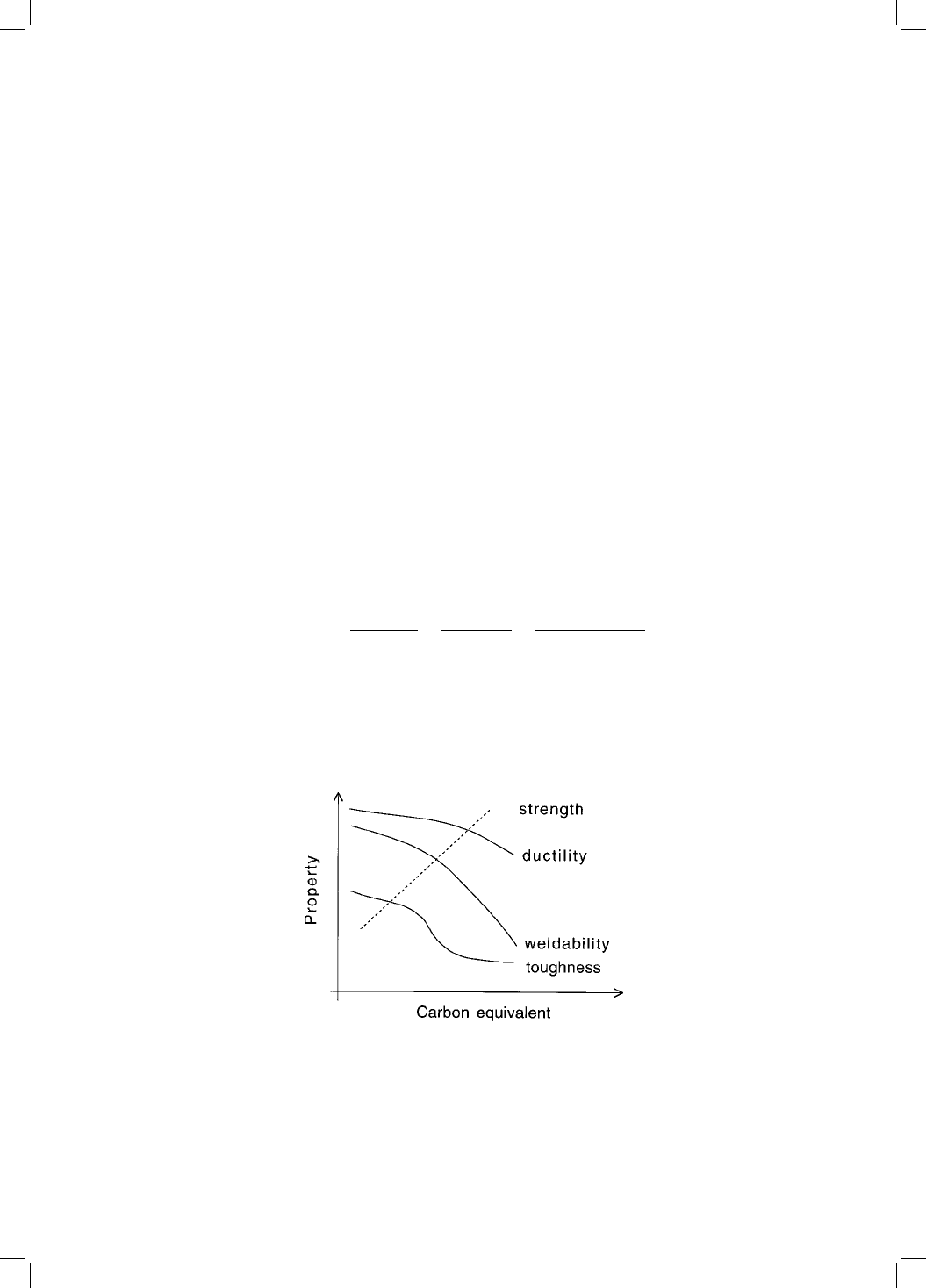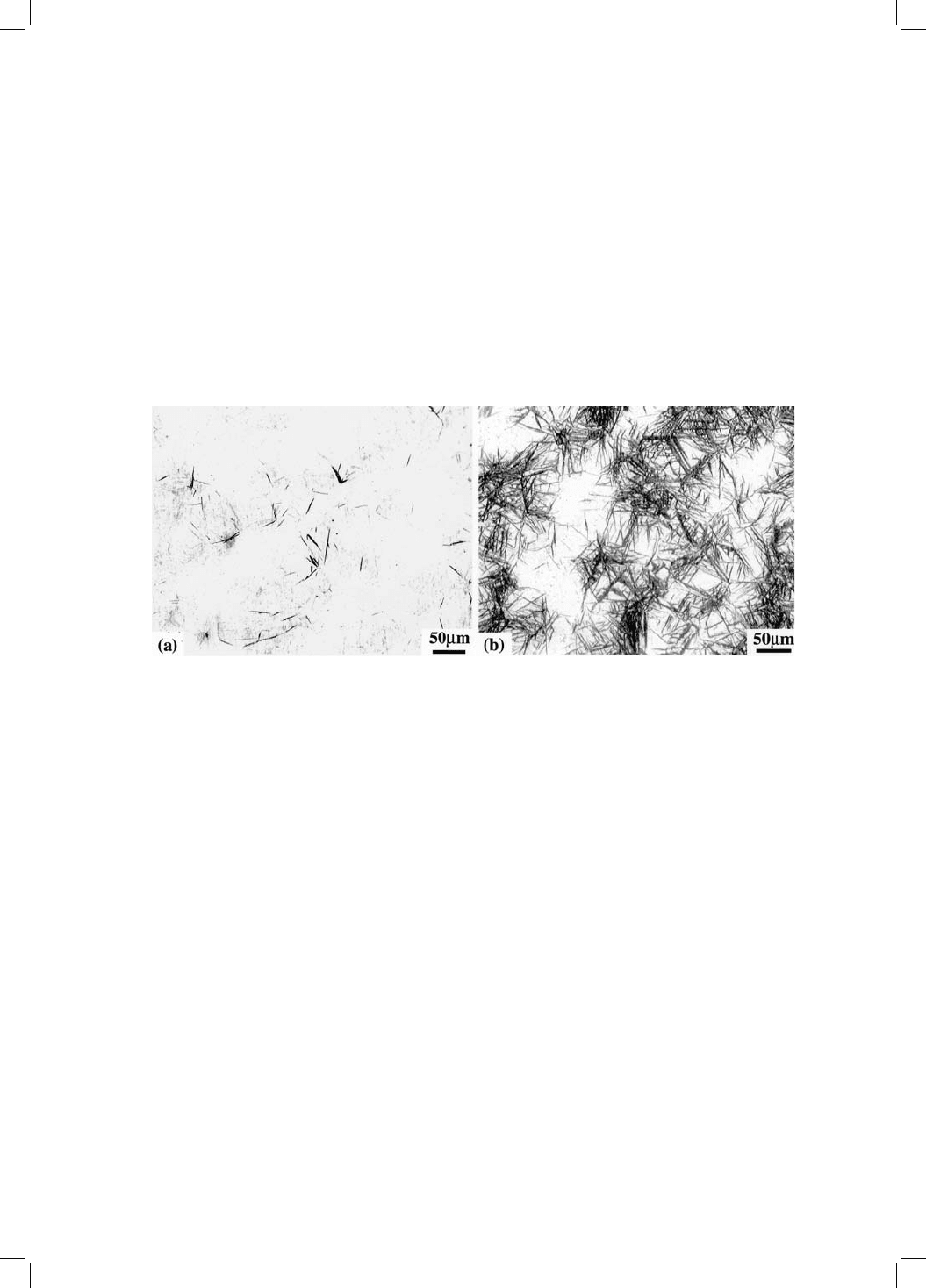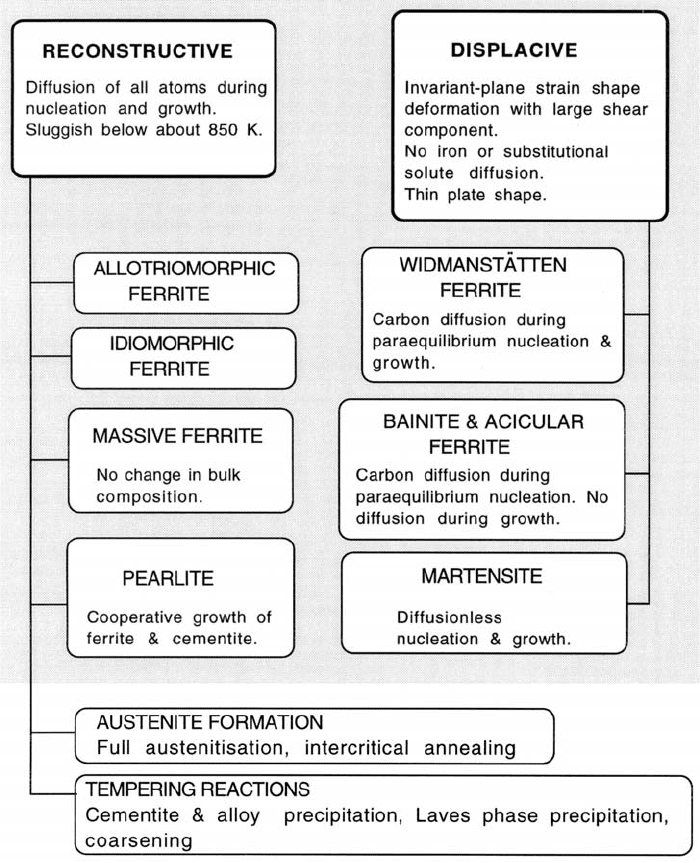Bhadeshia H.K.D.H. Bainite In Steels. Transformations, Microstructure and Properties
Подождите немного. Документ загружается.


14 Other Aspects
14.1 Bainite in Iron and its Substitutional Alloys
Bainite can be distinguished in high-purity iron or iron alloys which have an
interstitial content that is less than 0.01 wt%. Kinetic experiments are dif®cult
to conduct because the rate of reaction can be very large. The classi®cation of
microstructure therefore has to be based on limited evidence. The question
arises as to whether there is any essential difference between martensite and
bainite in interstitial-free alloys.
Many experiments have been conducted by monitoring the temperature
during rapid cooling. The evolution of latent heat due to transformation can
cause in¯exions in the cooling curves, which in turn indicate the onset of
transformation. Continuous cooling experiments on a Fe±14.43Ni±0.01C wt%
alloy revealed two plateaux in a plot of the thermal arrest temperature versus
the cooling rate (Wilson et al., 1982). The plateau at the higher temperature was
identi®ed with bainite, the other with martensite but the microstructural
evidence cited to support this interpretation was simply that the lath width
was larger for the higher temperature arrest.
There does not seem to be satisfactory evidence to suggest that there is any
difference in the mechanism of transformation between bainite and martensite
in interstitial-free alloys. On the basis of the theory discussed in Section 6.1.2,
the difference between bainite and martensite should vanish as the carbon
concentration is reduced to zero.
14.2 The Weldability of Bainitic Steels
The region which is adjacent to the fusion zone of a weld is in¯uenced by heat
diffusion from the fusion zone. This region is the heat-affected zone (HAZ). Its
boundaries need not be precisely de®ned because the de®nition depends on
purpose. The heat dissipated into the HAZ can be detected as the temperature
at any point rises to a maximum and then drops gently towards the far-®eld
temperature. The severity of the heating or cooling cycles, and the peak
temperature, depends on the location within the HAZ (e.g. Easterling, 1983;
[13:40 3/9/01 C:/3B2 Templates/keith/3750 BAINITE.605/3750-014.3d] Ref: 0000 Auth: Title: Chapter 00 Page: 397 397-404
397

Lancaster, 1986; Grong, 1997). For steels with a high hardenability, regions of
the HAZ which have been austenitised by the heat pulse may transform during
cooling into untempered martensite or to some other hard microstructure.
These hard regions are susceptible to cold-cracking due to hydrogen
embrittlement and other impurity effects.
This is the main reason why hardenable steels are dif®cult or impossible to
weld (Fig. 14.1). The cooling rate can be reduced during welding, to avoid the
formation of martensite in the HAZ. This can be done by heating the sample
before welding begins. But this preheating adds to the cost of manufacture. It
has been estimated, for example, that the cost of fabricating an aircraft carrier
could be reduced by about £3 million if the number of panels requiring preheat
can be reduced by 50% (Cullison, 1991).
The cold cracking susceptibility correlates empirically with a carbon
equivalent (CE), which is a measure of hardenability. There are two popular
formulae. The ®rst one is a slightly modi®ed version of the equation originally
proposed by Dearden and O'Neill, and adopted by the International Institute
for Welding. It is applied to steels containing less than 0.18 wt% of carbon:
IIW > 0:18 wt% C
CE C
Mn Si
6
Ni Cu
15
Cr Mo V
5
wt% 14:1
where all the concentrations are in wt%. The other equation, due to Ito and
Besseyo, has been adopted by the Japanese Welding Engineering Society:
Bainite in Steels
[13:41 3/9/01 C:/3B2 Templates/keith/3750 BAINITE.605/3750-014.3d] Ref: 0000 Auth: Title: Chapter 00 Page: 398 397-404
398
Fig. 14.1 Variation in mechanical properties of the heat-affected zone as a function
of the carbon equivalent.

Ito Besseyo < 0:18 wt% C
CE C
Si
30
Mn Cu Cr
20
Ni
60
Mo
15
V
10
5B wt% 14:2
It is generally accepted that if the carbon equivalent is between 0.35 and 0.55
wt%, then the sample must be preheated prior to welding (the preheat
temperature can be as high as 400 8C), and when CE > 0:55, both preheating
and postheating is considered essential to avoid cold-cracking and other
dif®culties.
The two equations give different values of CE, the Ito and Besseyo method
taking a more conservative account of alloying additions. Equation 14.2 is
appropriate for modern low-carbon, low-alloy steels such as the ultra-low-
carbon bainitic steels (C ' 0:01 ! 0:03 wt%, e.g. Nakasugi et al., 1980, Lorenz
and Duren, 1983). For these alloys, the IIW CE gives a pessimistic assessment of
weldability whereas the Ito and Besseyo equation works well. It has also been
demonstrated (Lorenz and Duren, 1983) that for low carbon pipeline steels, the
IIW CE overestimates the effects of alloying elements like manganese and
molybdenum, a more realistic CE being given by:
CE C
Si
25
Mn Cu
16
Cr
20
Ni
60
Mo
40
V
15
wt% 14:3
for weld cooling times of 2±3 seconds over the temperature range 800±500 8C
(these conditions are typical for girth welds in pipelines).
There are good reasons for supposing that the same CE should not apply to
medium-carbon and low-carbon steels. There is a disproportionate increase in
the growth rates of both allotriomorphic and Widmansta
È
tten ferrite as the
carbon concentration drops below ' 0:06 wt%, when compared with variations
in carbon above this value (Bhadeshia et al., 1985; Bhadeshia, 1990). This is
because the average carbon concentration of the alloy approaches the
equilibrium solubility of carbon in ferrite. The need to partition carbon into
the austenite is thus reduced so that the diffusion-controlled velocity rises
sharply.
14.3 Electrical Resistance
It follows from the Bloch theorem that anything which disrupts the periodic
potential of the lattice causes an increase in the electrical resistance. Thermal
vibrations, dislocations, solute atoms and other point defects therefore all
contribute to electrical resistance.
The role of dissolved carbon has been modelled by Hoffman and Cohen
(1973) using an analogy with the dynamic displacements associated with
thermal vibrations. The analogy seems to work well even though the dis-
Other Aspects
[13:41 3/9/01 C:/3B2 Templates/keith/3750 BAINITE.605/3750-014.3d] Ref: 0000 Auth: Title: Chapter 00 Page: 399 397-404
399

placements due to carbon are static. Thermal vibrations involve dynamic
displacements whose mean square value
u
2
T
is given by the Debye theory as:
u
2
T
u
2
0
145
MT
D
T
T
D
2
T=T
D
0
vdv
expfvg1
14:4
where
u
2
0
represent the zero-point quantum vibrations (the units of the
displacements are in A
Ê
), M is the atomic weight of iron in grams, v is a
dummy integration variable. Using equation 14.4,
u
2
T
u
2
0
is found to be 3:25
10
5
nm
2
at 295 K at which temperature the measured resistivity
T
9:8 cm. The ratio of the resistivity to mean square displacement is to
a good approximation found to be constant. If the static displacements due to
carbon are known, then this ratio can be used to estimate its contribution to
resistivity. The ratio is found to be about 30:3 cm per wt% C, in excellent
agreement with a variety of experimental measurements on martensite.
Bainite is expected to have a lower electrical resistivity than martensite
because it has less carbon in solid solution and a lower defect density. On
the other hand, its dislocation density is larger than that of pearlite or
allotriomorphic ferrite (Chapter 2). Therefore, the electrical resistivity of a
specimen fully reacted to bainite is always found to be higher than that of
pearlite at the same temperature (Radcliffe and Rollason, 1959). The resistivity
decreases in the order austenite, martensite, bainite and pearlite for a given
temperature; for a constant microstructure it decreases with temperature
(Fig. 14.2).
[13:41 3/9/01 C:/3B2 Templates/keith/3750 BAINITE.605/3750-014.3d] Ref: 0000 Auth: Title: Chapter 00 Page: 400 397-404
400
Fig. 14.2 Electrical resistivity of a variety of microstructures in steels (Radcliffe and
Rollason, 1959).

14.4 Internal Friction
A material is said to be elastic when it exhibits a stress±strain curve which is
fully reversible. The removal of stress eliminates the strain. The energy stored
in the material when under stress is fully recovered. When such a material
vibrates in a vacuum it may continue vibrating for an inde®nite period of time.
Similar vibrations would decay naturally in an anelastic solid, since energy is
dissipated by some process occurring within the sample during each vibration.
The vibrations are said to be damped. An examination of the damping as a
function of temperature and frequency can reveal information about the nature
of the dissipative process. Internal friction measurements like these can be used
to detect the onset of transformations, since moving interfaces can damp oscil-
lations.
Internal friction measurements conducted during the continuous cooling
transformation of a commercial steel to bainite have been interpreted to
indicate a prebainitic microstructural change before the formation of bainite
proper (Jihua et al., 1989). The argument is based on an observed rise in
damping during continuous cooling, at temperatures above B
S
. These experi-
ments are not supported by microstructural evidence nor is the association
with bainite proven.
The same experiments have demonstrated that the degree of damping
decreases monotonically as the transformation progresses, indicating that the
concentration of dissipative units (whatever they may be) varies directly with
the extent of reaction. The damping at any instant of time, increases as the
temperature is reduced below B
S
. This is expected because the total amount of
bainite that can form increases with undercooling below B
S
.
14.5 Internal Stress
It has long been recognised that the transformation of austenite to martensite
causes the development of stresses which are retained in the transformed
specimen. These residual stresses are usually attributed to the volume change
due to transformation (Buhler et al., 1932; Buhler and Scheil, 1933; Scheil, 1955;
Buhler, 1955; Hildenwall, 1979).
The volume expansion is not unique to martensite; allotriomorphic ferrite,
pearlite, Widmansta
È
tten ferrite, and bainite all cause a decrease in density.
There are no data for Widmansta
È
tten ferrite, but the formation of bainite
generates residual stresses (Radcliffe and Rollason, 1959; Diesburg et al.,
1981). As a general rule, X-ray diffraction peaks from transformations which
are displacive (martensite, bainite, Widmansta
È
tten ferrite) are found to be more
Other Aspects
[13:41 3/9/01 C:/3B2 Templates/keith/3750 BAINITE.605/3750-014.3d] Ref: 0000 Auth: Title: Chapter 00 Page: 401 397-404
401

diffuse than those from reconstructive reactions (allotriomorphic ferrite,
pearlite). For example, Radcliffe and Rollason demonstrated a larger lattice
strain with martensite and bainite than with pearlite. The diffusion that occurs
during reconstructive transformation help accommodate the volume change,
preventing the development of stresses.
The residual stresses develop mainly because transformation does not
usually occur uniformly in all regions of the sample. This can be exploited
for case-hardened components, where it is advantageous to have a compres-
sive stress on the surface of the component. The compressive stress prolongs
the fatigue life and makes the component more resistant to surface initiated
fracture. In steels which are surface carburised and then quenched, the lower
carbon core transforms at a higher temperature. The resulting core±volume
expansion puts the still austenitic surface regions into tension, though the
tensile stress is partly relaxed by plastic deformation. When the surface region
eventually transforms to martensite on further cooling, its volume expansion
causes stress reversal, so the surface ends up in compression relative to the
core (Koistinen, 1958).
Because of the smaller volume expansion that accompanies the transforma-
tion to bainite (Goldak et al., 1985), and since plastic relaxation eases at higher
temperatures, a bainitic case is not as effective in introducing a compressive
stress at the surface when compared with a martensitic case (Diesburg et al.,
1981). Samples containing bainite in the case have lower levels of compressive
residual surface stresses. Thus, the performance of case-hardened samples can
be improved by adding elements such as molybdenum which encourage
martensite to form at the expense of bainite.
14.6 Bainite in Iron±Nitrogen Alloys
Both nitrogen and carbon exist in interstitial sites in iron and their respective
binary phase diagrams with iron show eutectoid reactions in which austenite
decomposes into a mixture of ferrite and carbide or ferrite and nitride (Fe
4
N). It
is therefore reasonable to expect similar sorts of phase transformations to occur
in both alloy systems. It is well established that martensite can form in both
Fe±C and Fe±N alloys, but the ®rst report of bainite in an Fe±N alloy was by
Bell and Farnell (1969). A Fe±1.8N wt% alloy when transformed isothermally at
350 8C was observed using light microscopy to contain ferrite and Fe
4
N with an
appearance similar to that of upper bainite in Fe±C alloys. The transformation
products were sti¯ed in their growth by austenite twin boundaries, consistent
with growth in which there is a co-ordinated movement of atoms.
Foct et al. (1988) showed that in a Fe±9N at.% alloy, the transformation to
bainite is sometimes preceded by the precipitation of Fe
4
N. The resulting
Bainite in Steels
[13:41 3/9/01 C:/3B2 Templates/keith/3750 BAINITE.605/3750-014.3d] Ref: 0000 Auth: Title: Chapter 00 Page: 402 397-404
402

localised depletion of nitrogen then stimulates the austenite to transform into
bainitic ferrite and more Fe
4
N, without any change in the lattice parameter of
the residual austenite.
Whilst there is evidence for the existence of a bainite reaction in Fe±N alloys,
it would be useful to conduct a detailed microstructural characterisation,
thermodynamic analysis and crystallographic experiments including the
study of surface relief.
14.7 Effect of Hydrogen on Bainite Formation
Hydrogen has a bad reputation in the context of steels because when in solu-
tion, it undoubtedly embrittles ferrite. However, there are examples in tita-
nium metallurgy where it is introduced temporarily to enable processing,
after which it is removed by heat treatment. With this in mind, Yalci and
Edmonds (1999) conducted what is probably the ®rst study on the in¯uence
of hydrogen on the microstructure and properties of upper bainite.
The studies were conducted on silicon-rich steels to avoid the formation of
cementite. The hydrogen was introduced at a pressure of two atmospheres,
whilst the alloys were in the austenite phase ®eld. This was followed imme-
diately by isothermal transformation in the bainite temperature range.
The introduction of hydrogen apparently led to a greater amount of upper
bainite and the thickness of bainite plates was reduced from 0:31 0:06 mmto
0:21 0:09 mm in the hydrogenated alloy. The hardness of the hydrogenated
samples was measured to be greater than those which were simply heat treated
in helium (Table 14.1). The increase in hardness in the hydrogenated samples is
consistent with an increase in the fraction of bainite, since ferrite is at low
temperatures harder than austenite.
Other Aspects
[13:41 3/9/01 C:/3B2 Templates/keith/3750 BAINITE.605/3750-014.3d] Ref: 0000 Auth: Title: Chapter 00 Page: 403 397-404
403
Table 14.1 Hardness of Fe±0.2C±3Mn±2.1Si wt% and Fe±0.4C±4.09Ni±1.99Si wt%
alloy transformed isothermally at 390 8C after austenitisation at 920 8C for 30 min. The
samples were sealed in chambers containing either helium or hydrogen at 2 atmospheres
pressure throughout these heat-treatments. After Yalci and Edmonds (1999). HV
30
refers
to the Vicker's hardness measured using a 30 kg load.
Alloy
Environment
Mn-containing alloy
ÐÐÐÐÐÐÐÐÐÐÐÐÐÐ
Helium Hydrogen
Ni-containing alloy
ÐÐÐÐÐÐÐÐÐÐÐÐÐÐÐÐ
Helium Hydrogen
HV
30
367 409 364 383

14.8 Magnetically-Induced Bainite
It has long been known the magnetic ®elds must in¯uence the transformation
from austenite to martensite (Krivoglaz and Sadovskii, 1964; Kekeshita et al.,
1985). The two phases have different magnetic properties so the application of
a magnetic ®eld encourages the formation of the ferromagnetic martensite.
Ohtsuka and coworkers (2000) have recently veri®ed the same effect of an
externally applied magnetic ®eld on the bainite transformation. The major
effect of the ®eld is to accelerate transformation (Fig. 14.3).
Bainite in Steels
[13:41 3/9/01 C:/3B2 Templates/keith/3750 BAINITE.605/3750-014.3d] Ref: 0000 Auth: Title: Chapter 00 Page: 404 397-404
404
Fig. 14.3 A Fe±0.52C±0.24Si±0.84Mn±1.76Ni±1.27Cr±0.35Mo±0.13V wt% steel aus-
tenitised at 1273 K for 600 s and transformed isothermally to bainite at 573 K for
480 s, followed by helium quenching to ambient temperature: (a) zero magnetic
®eld; (b) sample under the in¯uence of a 10 Tesla magnetic ®eld during transfor-
mation.
15 The Transformations in Steel
Probably the most interesting revelations are made when all of the decom-
position reactions of austenite are examined together. And the most awkward
question seeks to discover the difference between the variety of transformation
products. This chapter is intended to be a brief picture of how these trans-
formations ®t together, in a way which is consistent with the available
experimental and theoretical data (Fig. 15.1).
There is ample evidence that the different forms of ferrite can be categorised
into those which grow by displacive transformation and the others which grow
by a reconstructive mechanism. Amongst the displacive transformations are
Widmansta
È
tten ferrite, bainite, acicular ferrite and martensite, all of which are
characterised uniquely by their plate or lath shapes and the striking invariant-
plane strain surface relief which accompanies transformation. An important
feature of this strain is the large shear component which is the dominant
reason for the plate shape of the transformation product. There is no equili-
brium at the transformation front; substitutional solutes do not partition
between the parent and product phases.
Widmansta
È
tten ferrite grows at high temperatures by a paraequilibrium
mechanism in which the plates lengthen at a rate controlled by the diffusion
of carbon in austenite. This diffusion does not contradict its displacive
character because interstitials can migrate without affecting the IPS shape
deformation. The transformation occurs at small driving forces, so that the
shape change consists of two adjacent invariant-plane strains which tend to
mutually accommodate and hence reduce the strain energy. This also explains
the thin-wedge shape of Widmansta
È
tten ferrite because the adjacent plates are
different crystallographic variants (Fig. 15.2).
Carbon must diffuse during the nucleation of both Widmansta
È
tten ferrite
and bainite. Nucleation probably occurs by a process akin to the dissociation of
arrays of dislocations. This follows from the observation that the activation
energy for nucleation is directly proportional to the driving force, rather
than the inverse square relationship implied by a heterophase ¯uctuation
model of nucleation. Both Widmansta
È
tten ferrite and bainite develop from
the same nucleus; it develops into bainite if diffusionless growth is possible
at the temperature where nucleation becomes possible. Otherwise it evolves
into Widmansta
È
tten ferrite.
405

Bainite probably grows without diffusion, but excess carbon is soon after
transformation, rejected into the residual austenite. The partitioned carbon
may then precipitate as carbides, giving the classical upper bainitic micro-
structure. At somewhat lower transformation temperatures where the
Bainite in Steels
406
Fig. 15.1 Flowchart summarising the characteristics of transformations in steels.
